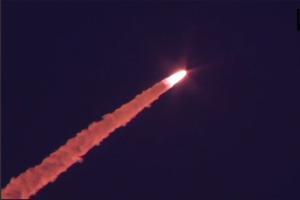The RISAT-2B is equipped with a synthetic aperture radar that can take pictures of the earth during day and night, and also under cloudy conditions

Pic/Twitter
In a pre-dawn launch on Wednesday, Indian space agency ISRO scripted history by successfully launching earth observation satellite RISAT-2B that would enhance the country's surveillance capabilities among others.
ADVERTISEMENT
As the 25-hour countdown which had begun on Tuesday concluded, the agency's trusted workhorse, the Polar Satellite Launch Vehicle (PSLV-C46) blasted off at 5.30 am from the first launch pad of the Satish Dhawan Space Centre on its 48th mission, carrying the 615 kg satellite.
The RISAT-2B (Radar Imaging Satellite-2B), meant for application in fields such as surveillance, agriculture, forestry and disaster management support, was successfully released into its orbit at about 15 minutes and 30 seconds after the lift-off.
Commenting on the launch from the Mission Control Centre, ISRO Chairman K Sivan said that the PSLV-C46 successfully injected RISAT-2B precisely in the designated orbit of 555 km, with an inclination of 37 degrees.
"This particular mission for PSLV is a very, very important mission. With this launch, PSLV lofts 50 tonnes to space by launching 354 satellites, including national, student and foreign satellites," Sivan said.
The ISRO chairman said the PSLV-C46 carried two important piggyback payloads, an indigenously developed processor and a low-cost Inertial Navigation System. "It is going to revolutionise our future launch vehicle missions," he said.
Sivan said the RISAT-2B is an advanced earth observation satellite. "In this satellite, another very complex new technology has flown. That is a 3.6-metre unfurlable radial rib antenna. This is also going to be the technology of the future," he added.
u00f0u009fu0087u00aeu00f0u009fu0087u00b3 #ISROMissions u00f0u009fu0087u00aeu00f0u009fu0087u00b3
— ISRO (@isro) May 22, 2019
For those who missed watching the launch live, take a look at the majestic lift-off of #PSLVC46!
Mission accomplished successfully! pic.twitter.com/Nec1XkQ7bt
On future launches, Sivan said, "The next mission -- Chandrayaan-2 -- is going to be a landmark mission for India. It is going to be the most complex mission ever undertaken by ISRO. It is going to take place between July 9 and July 16 this year."
He added that the landing on the moon is expected to be on September 6. "It is going to land at a particular location where nobody has gone before." After Chandrayaan-2, Sivan said, "ISRO would look at launching the very high-resolution CARTOSAT 3 satellite."
#ISROMissions#PSLVC46 lifts-off from Sriharikota.
— ISRO (@isro) May 22, 2019
Here's a shot of the first stage separation.
Stay tuned !!! pic.twitter.com/qJ20Zfprmr
"A second demonstration of the reusable launch vehicle is going to happen in the coming months. Cost effective small satellite launch vehicle developments are also going to take place in a few months from now," he added.
RISAT-2B launched on Wednesday would replace the RISAT-2, which was successfully launched in 2009. The RISAT-2B is equipped with a synthetic aperture radar that can take pictures of the earth during day and night, and also under cloudy conditions.
With a mission life of five years, the satellite would also be used for military surveillance, ISRO sources told PTI. The RISAT-2 has been actively used by India to monitor activities in camps across the border in Pakistan to thwart infiltration bids by terrorists.
Indian Space Research Organisation (ISRO) launches PSLVC46 from Satish Dhawan Space Centre, Sriharikota. PSLVC46 will launch the RISAT-2B radar earth observation satellite into a 555 km-altitude orbit. pic.twitter.com/iY2paDVjls
— ANI (@ANI) May 22, 2019
The PSLV-C46 was the 14th flight of the PSLV in its core-alone configuration sans the use of the solid strap-on motors. It was the 72nd launch vehicle mission from Sriharikota and also marked the 36th launch from the first launch pad.
ISRO: #PSLVC46 successfully injects #RISAT2B into Low Earth Orbit. pic.twitter.com/FoS7yroqGX
— ANI (@ANI) May 22, 2019
Wednesday's launch of the PSLV also marked the third launch in 2019.
The other two were the PSLV-C45/EMISAT mission, which successfully injected the EMISAT and 29 international customer satellites into their orbits on April 1, and the PSLV-C44, which successfully placed the Microsat-R and the Kalamsat-V2 satellites in designated orbits on January 24.
ISRO had launched RISAT-1, a microwave remote sensing satellite, on April 26, 2012 from Sriharikota.
Catch up on all the latest Crime, National, International and Hatke news here. Also, download the new mid-day Android and iOS apps to get the latest updates
Edited by mid-day online desk with inputs from Agencies
 Subscribe today by clicking the link and stay updated with the latest news!" Click here!
Subscribe today by clicking the link and stay updated with the latest news!" Click here!






